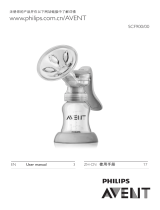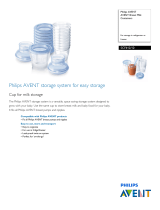
3 Press the assembled pump body against your breast. Make sure that your nipple is centered,
so that the massage cushion creates an airtight seal.
Note: Make sure that your nipple ts correctly in the massage cushion (Fig. 10). Not too
tight, it is important that the nipple can move freely, while expressing breast milk (Fig. 11).
The massage cushion should not be too large, because this can cause pain or less eective
expression (Fig. 12). If the cushion is not the right size for your nipples, you can purchase a
cushion of a dierent size separately. Two cushion sizes are available: 19.5 mm and 25 mm.
You can nd the size of the cushion (19.5 or 25 mm) on the cushion itself (Fig. 13).
4 Gently start to press down the handle until you feel the suction on your breast (Fig. 14).
Then allow the handle to return to its resting position.
Note: You do not have to press down the handle fully, only as much as is comfortable.
Your milk will soon start owing, even though you are not using all the suction the pump
can generate.
5 Repeat step 4 rapidly 5 or 6 times to initiate the ‘let-down’ reex.
Warning: Do not continue pumping for more than ve minutes at a time if you do
not succeed in expressing any milk. Try to express at another time during the day.
6 Adopt a slower rhythm by pressing down the handle and keeping it pressed down for up to
3 seconds before you let it return to its resting position. Continue in this way while your milk
is owing. If your hand becomes tired, try to use the other hand to operate the breast pump
or rest your arm across your body to pump from the opposite breast.
Note: Do not worry if your milk does not ow immediately. Relax and continue pumping.
Repositioning the breast pump on your breast from time to time can help stimulate milk ow.
7 On average, you need to pump for 10 minutes to express 60-125 ml (2-4 oz) of breast milk
from one breast. However, this is just an indication and varies from woman to woman.
8 When you have nished expressing, carefully remove the breast pump from your breast
and unscrew the bottle or storage cup from the pump body, ready for feeding or storage.
Clean the other used parts of the breast pump.
Note: If you regularly express more than 125 ml per session, you can purchase and use a
260 ml (9 oz) Philips Avent bottle to prevent overlling and spillage.
After use
Storing breast milk
Warning: Only store breast milk collected with a clean and disinfected pump.
Breast milk can be stored in the fridge (not in the door) for up to 48 hours. Expressed milk
should be refrigerated immediately. If you store milk in the fridge to add to during the day, only
add milk that has been expressed into a clean and disinfected bottle or breast milk container.
Breast milk can be stored in the freezer for up to three months as long as it is kept in either
disinfected bottles tted with a disinfected screw ring and sealing disc or in disinfected storage
cups with a disinfected lid. Clearly label the bottle or storage cup with the date and time of
expression and use older breast milk rst.
10 English

























